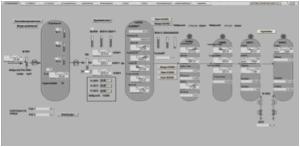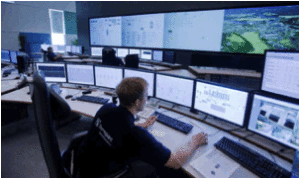With Ian Nimmo’s Help Borregaard Consolidates 8 Control Rooms
Dag Skjeltorp and Egil Willy Karlsen have become control room ergonomics experts. “We know a lot about HMIs now,” Skjeltorp said. “It is very, very easy to buy the wrong stuff.” Karlsen stressed the importance of defining HMI needs first when designing operator consoles.
 They started, Karlsen said, in 2001 with a project to re-design the eight control rooms in their former paper and pulp mill and see what synergies and combinations could be achieved. The Borregaard Sarpsborg mill now produces lignin, vanillin, bioethanol, other specialty chemicals, cellulose and other specialty products made from pulp stock.
They started, Karlsen said, in 2001 with a project to re-design the eight control rooms in their former paper and pulp mill and see what synergies and combinations could be achieved. The Borregaard Sarpsborg mill now produces lignin, vanillin, bioethanol, other specialty chemicals, cellulose and other specialty products made from pulp stock.
By 2008, they were ready to propose to management that they combine the eight control rooms into one. They proposed this would require fewer console operators, improve training and simulation with less administrative overhead and produce a uniform organizational focus on production.
Right away, Karlsen said, they knew they needed to start with cultural change. They even negotiated a pilot agreement with the union to permit them to try new methods and modes of operation. They also knew from the start they needed to institute a rigorous MOC (management of change) procedure.
After bringing in consultants, they had standardized on Honeywell control systems in 2001. However, the Borregaard facility is old enough to have control systems from several different vendors, some of which date back to 1990. “You can ask me about migration, too,” Skjeltorp quipped. “I know a lot about that too.”
One of the consultants they worked with was Ian Nimmo of User Centered Design Services in Phoenix, Ariz. Nimmo helped them put together a design plan for a consolidated central control room. The Borregaard engineers produced a control room design with eight control stations, one for each plant unit, and a video wall that was intended to some extent to replicate the analog “panel wall” of the 1960s – to provide the situational awareness that operators need. “You have to do the design of the HMI first,” Skjeltorp said, “because it is very, very easy to buy the wrong stuff.”
Seven operators manage 20,000 loops in this control room. Borregaard has also completed an ongoing alarm management program.
The Borregaard management’s dream is for the control system to consist of two buttons: “start” and “stop” with an option to remove the “stop” button. “We’re not quite there yet,” Skjeltorp said.
In 2001 Borregaard started on the route to gather operations from all its different process units into one centralized control room with a common Human-Machine Interface (HMI) for all operators. At that time, the company purchased its first Honeywell system to operate a new recovery boiler. The plan was to operate this boiler, together with oil/electrical boilers, an SO2 boiler, and water/wastewater treatment systems, from a common control room and operator interface. Experience gathered from this pilot project, together with the challenge of reducing operational costs, caused Borregaard to undertake a reorganization of all its operations. Based on pre-studies, a formal decision was made in November 2008 to proceed with the project.
This included upgrading legacy Honeywell automation systems to the latest Experion System, as well as migrating outdated, third-party Distributed Control System (DCS) and Programmable Logic Control (PLC)-based systems to a common automation platform.
Borregaard operates the world’s most advanced biorefinery, and is an international company with strong global presence in wood-based chemicals and other selected niches of organic chemicals. It develops and supplies specialty cellulose, lignin products, vanillin and bioethanol for a wide range of applications. Borregaard has production plants and sales offices in 20 countries.
Borregaard’s pulp & paper operation in Sarpsborg, Norway, was originally established in 1889. Over the years, significant investments have been made in the facility, including a new pulp-drying machine; new cutting, baling and, reeling equipment; and conversion of the bleaching plant to sulphite pulp. The original digester house, built in the early 1950s, was completely modernized with new stainless steel digesters and a new chemiwasher. As a result of this, the entire pulp line has been either rebuilt or refurbished, which makes the Sarpsborg site the most modern sulfite plant in the world.
 Challenges
Challenges
In 2002, Borregaard installed two Honeywell systems at the Sarpsborg facility in order to standardize control systems for its water treatment plant, boiler house and recovery boiler. This was the beginning of a five-year project focused on centralizing process automation under a single control center, including replacement or interfacing of existing Foxboro IA, Fisher-Rosemont RS3, Emerson DeltaV and PLC-based systems, as well as the older Honeywell TDC 2000/3000 systems. The goal was to reduce complexity and increase productivity throughout the production operation.
Management at the Sarpsborg mill sought a secure, predictable technology migration path for the long haul, combining the existing, disparate systems into one powerful and centralized automation solution, which would enable operators to oversee production processes from a single control platform with a common HMI.
The key project requirements included:
• Ability to standardize on a platform that afforded flexibility and increased reliability and efficiency
• Centralized control room with common operator interface
• New, state-of-the-art automation system to reduce the number of required resources
• Enhanced HMI to help operators perform their jobs more efficiently and effectively
Borregaard was faced with minimizing cutover time and reducing risk through stepwise implementation of new control technology, since lost production would translate into lost profits. Most of the system migrations had to be completed during very short shutdown periods, which required reusing existing field termination as much as possible while replacing all controllers and I/O boards to gain the advantages provided by modern control technology.
New Technology
The mill’s process control network employs a Distributed Server Architecture (DSA) to consolidate operator consoles across their multiple systems. It enables global access to points, alarms, interactive operator control messages, and history data across the different systems, eliminating the need for database duplication and gateways.
Borregaard’s new centralized control center utilizes HTML as the native display format to provide access to process graphic displays from the Experion Station environment. The use of an open, industry standard file format reduces engineering time while allowing displays to be reused between systems.
As part of the enhanced HMI design based Abnormal Situation Management (ASM®) Consortium guidelines, level one overview displays provide operators and operations management with a view of abnormal operating conditions (often as large screen displays). Level two overview displays contain the positions control room personnel frequently use in specific operating situations (e.g., startup/shut down or normal stable production). Level three displays include traditional PI&D graphics showing every detail of the process and related instrumentation. Level four detail displays, faceplates and pop-ups provide the details of devices, group starts, etc.
New level 2 HMI display:
 Borregaard’s Digital Video Manager (DVM) installation includes 100 analog cameras connected to 14 different matrixes. Camera signals are converted to digital streams, which are then distributed through the Local Area Network (LAN). The consoles not only show live video from locations throughout the mill, but also provide the ability to switch cameras, and pan, tilt or zoom the camera to focus in on a particular area. This allows the mill to extend its remote monitoring capabilities and integrate video stream and analytics with process control applications. Additionally, it enables operators to observe hazardous or inaccessible areas from a distance and detect events beyond traditional sensor capabilities. They can even monitor workers and validate potential environmental and safety incidents
Borregaard’s Digital Video Manager (DVM) installation includes 100 analog cameras connected to 14 different matrixes. Camera signals are converted to digital streams, which are then distributed through the Local Area Network (LAN). The consoles not only show live video from locations throughout the mill, but also provide the ability to switch cameras, and pan, tilt or zoom the camera to focus in on a particular area. This allows the mill to extend its remote monitoring capabilities and integrate video stream and analytics with process control applications. Additionally, it enables operators to observe hazardous or inaccessible areas from a distance and detect events beyond traditional sensor capabilities. They can even monitor workers and validate potential environmental and safety incidents
Borregaard also implemented FOUNDATION™ fieldbus, which when integrated with Experion, helped them decrease commissioning time.
Project Results
Since 2001, Borregaard has gone through various installation phases of its automation system upgrade. The company established a mill-wide standard that handled continuous upgrades and defined a vertical migration strategy enabling it to implement new technology without any production loss.
More than 20,000 control loops are currently managed from the mill’s centralized control center, while the number of console operators has been reduced from 12 to 6 per shift—with the potential for further reductions. A stepwise transfer of operators into the new control room proved to be effective. Operators with pilot training quickly became accustomed to the new surroundings and adapted to the updated control system. There is increased interaction between personnel who have a better process understanding of the entire plant, and managers now have quick access to mill operation status.
Going forward, Borregaard plans to reduce the number of servers. All servers will be moved to a new server room, with implementation of a remote backup location, patch management and remote support. In addition, the next generation of level one display development will be focused on reducing the number of parameters and Key Performance Indicators (KPIs), and on improving shapes. This will be accompanied by additional training for operators on level one and level two displays, as well as further education of personnel in utilizing trends, alarms, event logs, and detail displays.
New advanced alarm management and advanced control applications are also on the horizon. More than 20,000 control loops are currently managed from the mill’s centralized control center.

